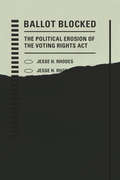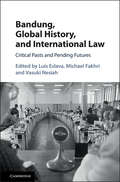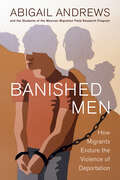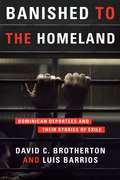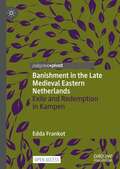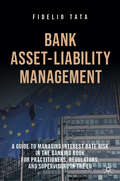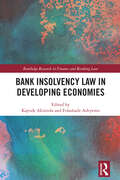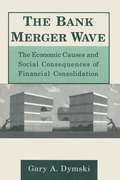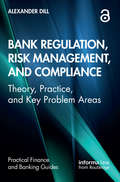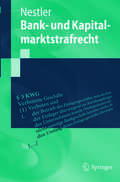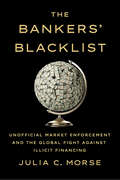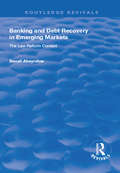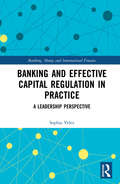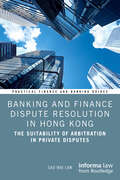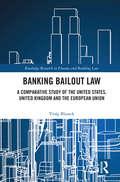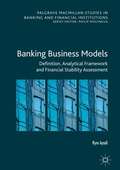- Table View
- List View
Ballistics: Theory and Design of Guns and Ammunition, Third Edition
by Donald E. Carlucci Sidney S. JacobsonWith new chapters, homework problems, case studies, figures, and examples, Ballistics: Theory and Design of Guns and Ammunition, Third Edition encourages superior design and innovative applications in the field of ballistics. It examines the analytical and computational tools for predicting a weapon’s behavior in terms of pressure, stress, and velocity, demonstrating their applications in ammunition and weapons design. New coverage in the Third Edition includes gas-powered guns, and naval ordinance. With its thorough coverage of interior, exterior and terminal ballistics, this new edition continues to be the standard resource for those studying the technology of guns and ammunition.
Ballistics: Theory and Design of Guns and Ammunition
by Donald E. Carlucci Sidney S. JacobsonBallistics examines the analytical and computational tools for predicting a weapon’s behavior in terms of pressure, stress, and velocity, demonstrating their applications in ammunition and weapons design. It includes updated and revised equations, end-of-chapter problems, case studies, and practical examples.Explaining the physics of a gun launch, the book describes the behavior of the propelling charge that moves the projectile through the gun tube and the necessary methods to calculate how the projectile will fly. The new edition features a new chapter on closed vessel experimentation and analysis, which discusses closed bomb testing to incorporate new propellants into interior ballistics designs. It covers the mathematical fundamentals that are key to developing a safe and reliable gun system.With its thorough coverage of interior, exterior, and terminal ballistics, this new edition continues to be the standard resource for ballistics experts and researchers studying the technology of guns and ammunition and designing state-of-the-art propellants.Instructors will be able to utilize a Solutions Manual and Figure Slides for their course.
Ballot Blocked: The Political Erosion of the Voting Rights Act
by Jesse H. RhodesVoting rights are a perennial topic in American politics. Recent elections and the Supreme Court's decision in Shelby County v. Holder, which struck down key enforcement provisions in the Voting Rights Act (VRA), have only placed further emphasis on the debate over voter disenfranchaisement. Over the past five decades, both Democrats and Republicans in Congress have consistently voted to expand the protections offered to vulnerable voters by the Voting Rights Act. And yet, the administration of the VRA has become more fragmented and judicial interpretation of its terms has become much less generous. Why have Republicans consistently adopted administrative and judicial decisions that undermine legislation they repeatedly endorse? Ballot Blocked shows how the divergent trajectories of legislation, administration, and judicial interpretation in voting rights policymaking derive largely from efforts by conservative politicians to narrow the scope of federal enforcement while at the same time preserving their public reputations as supporters of racial equality and minority voting rights. Jesse H. Rhodes argues that conservatives adopt a paradoxical strategy in which they acquiesce to expansive voting rights protections in Congress (where decisions are visible and easily traceable) while simultaneously narrowing the scope of federal enforcement via administrative and judicial maneuvers (which are less visible and harder to trace). Over time, the repeated execution of this strategy has enabled a conservative Supreme Court to exercise preponderant influence over the scope of federal enforcement.
The Banality of Evil: The Counter-Image of God in Nazi Logic
by Ana Rubio-SerranoThe aim of this book is not only to show the historical Auschwitz but the Auschwitz that has taken root in human beings: first, the inability to distinguish between good and evil; second, the obsession for reaffirming one's own identity as uniquely human and third, the impossibility of thinking about otherness. Even today, Auschwitz persists as a legacy, of which our world is both executor and heir. Auschwitz is, therefore, the starting point, but not the endpoint. This book is a study that shows the model of the anti-human that is born of Nazi anthropology, contrary to the model of man revealed by Christian anthropology. A humanistically oriented theological and philosophical examination of the "banality of evil" within the universe of the Nazi extermination camps.
Bandit Capitalism: Carillion and the Corruption of the British State
by Bob Wylie“Comparable with Michael Lewis’ The Big Short or indeed Ian Fraser’s Shredded, Bob Wylie has done a forensic job . . . a powerful book.” —Talk Media PodcastThe collapse in January 2018 of the construction giant Carillion, outsourcer of huge Government building contracts, is one of the great financial scandals of modern times. When it folded it had only £29 million in the bank and debts and other liabilities adding up to a staggering £7 billion. When the total losses were counted it was established that the banks were owed £1.3 billion in loans and that there was a hole in the pension fund of £2.6 billion. That left British taxpayers picking up the tab to salvage the pensions owed to Carillion workers.On one level, this is a familiar story of directors who systematically looted a company with the aim of their own enrichment. But in a wider context the Carillion catastrophe exposes everything that is wrong about the state we are in now—the free-for-all of company laws which govern directors’ dealings, the toothless regulators, the crime and very little punishment of the Big Four auditors, and a government which is a prisoner of a broken model born of a political ideology which it cannot forsake. Through the story of Carillion, Bob Wylie exposes the lawlessness of contemporary capitalism that is facilitated by hapless politicians, and gives a warning for the future that must be heeded. Bandit Capitalism charts, in jaw-dropping detail, the rise and rise of the British Oligarchy.“An excoriating book on the corruption that can lurk within contemporary capitalism.” —Financial Times, “Best Books of 2020”
Bandits and Bureaucrats The Ottoman Route the State Centralization
by Karen BarkeyDiscusses the process of state-building in the Ottoman Empire.
Bandung, Global History, and International Law: Critical Pasts and Pending Futures
by Partha Chatterjee Michael Fakhri Luis Eslava Vasuki Nesiah Abi-Saab GeorgesIn 1955, a conference was held in Bandung, Indonesia that was attended by representatives from twenty-nine nations. Against the backdrop of crumbling European empires, Asian and African leaders forged new alliances and established anti-imperial principles for a new world order. The conference came to capture popular imaginations across the Global South and, as counterpoint to the dominant world order, it became both an act of collective imagination and a practical political project for decolonization that inspired a range of social movements, diplomatic efforts, institutional experiments and heterodox visions of the history and future of the world. In this book, leading international scholars explore what the spirit of Bandung has meant to people across the world over the past decades and what it means today. It analyzes Bandung's complicated and pivotal impact on global history, international law and, most of all, justice struggles after the end of formal colonialism.
Banging on the Walls of the Tank: Dispatches from Gaza
by Haidar EidBanging on the Walls of the Tank is a collection of reflections and analysis written over eighteen years in Gaza by Palestinian academic and activist, Haidar Eid. Providing an insider’s perspective on the blockade of Gaza since 2007, the Israeli attacks in 2009, 2012, 2014, and 2021, the Great March of Return, and the ongoing genocide committed by the apartheid Israeli state, Eid’s essays examine political alternatives, opportunities for resistance, and prospects for a just peace after more than a century of dispossession.
Banished Men: How Migrants Endure the Violence of Deportation
by Abigail Leslie AndrewsA free ebook version of this title is available through Luminos, University of California Press’s Open Access publishing program. Visit www.luminosoa.org to learn more. What becomes of men the U.S. locks up and kicks out? From 2009 to 2020, the U.S. deported more than five million people—over 90 percent of them men. In Banished Men, Abigail Andrews and her students tell 186 of their stories. How, they ask, does expulsion shape men's lives and sense of themselves? The book uncovers a harrowing carceral system that weaves together policing, prison, detention, removal, and border militarization to undermine migrants as men. Guards and gangs beat them down, till they feel like cockroaches, pigs, or dogs. Many lose ties with family. They do not go "home." Instead, they end up in limbo: stripped of their very humanity. Against the odds, they fight for new ways to belong. At once devastating and humane, Banished Men offers a clear-eyed critique of the violence of deportation.
Banished to the Homeland: Dominican Deportees and Their Stories of Exile
by David C. Brotherton Luis BarriosThe 1996 U.S. Immigration Reform and Responsibility Act has led to the forcible deportation of tens of thousands of Dominicans from the United States. Following thousands of these individuals over a seven-year period, David C. Brotherton and Luis Barrios use a unique combination of sociological and criminological reasoning to isolate the forces that motivate emigrants to leave their homeland and then commit crimes in the Unites States violating the very terms of their stay. Housed in urban landscapes rife with gangs, drugs, and tenuous working conditions, these individuals, the authors find, repeatedly play out a tragic scenario, influenced by long-standing historical injustices, punitive politics, and increasingly conservative attitudes undermining basic human rights and freedoms. Brotherton and Barrios conclude that a simultaneous process of cultural inclusion and socioeconomic exclusion best explains the trajectory of emigration, settlement, and rejection, and they mark in the behavior of deportees the contradictory effects of dependency and colonialism: the seductive draw of capitalism typified by the American dream versus the material needs of immigrant life; the interests of an elite security state versus the desires of immigrant workers and families to succeed; and the ambitions of the Latino community versus the political realities of those designing crime and immigration laws, which disadvantage poor and vulnerable populations. Filled with riveting life stories and uncommon ethnographic research, this volume relates the modern deportee's journey to broader theoretical studies in transnationalism, assimilation, and social control.
Banishment in the Late Medieval Eastern Netherlands: Exile and Redemption in Kampen
by Edda FrankotThis open access book analyses the practice of banishment and what it can tell us about the values of late medieval society concerning morally acceptable behaviour. It focuses on the Dutch town of Kampen and considers the exclusion of offenders through banishment and the redemption of individuals after their exile. Banishment was a common punishment in late medieval Europe, especially for sexual offences. In Kampen it was also meted out as a consequence of the non-payment of fines, after which people could arrange repayment schemes which allowed them to return. The books firstly considers the legal context of the practice of banishment, before discussing punishment in Kampen more generally. In the third chapter the legal practice of banishment as a punitive and coercive measure is discussed. The final chapter focuses on the redemption of exiles, either because their punishment was completed, or because they arranged for the payment of outstanding fines.
Bank Asset-Liability Management: A Guide to Managing Interest Rate Risk in the Banking Book for Practitioners, Regulators, and Supervisors in the EU
by Fidelio TataThis book provides a practical and intuitive view of how European banks manage asset-liability mismatch risk from both a practitioner and supervisory perspective. After a prolonged period of zero interest rate policy (ZIRP) by central banks around the world, the period from Q1 2022 to Q2 2023 has seen the largest, fastest, and most widespread increase in interest rates since the 1980s, with 1-year euro yields rising by more than 400 bp. The recent market turmoil has exposed the increased vulnerability of banks, particularly those with significant exposures to long-term, fixed income assets, fueled by shorter-term, less stable funding. This challenging interest rate environment reinforces the strategic importance of asset-liability management (ALM) for banks. Indeed, a bank's survival now depends more than ever on prudent ALM. This book introduces the most common components of interest rate risk management within a bank's asset-liability management framework, including the concepts of economic value of equity (EVE), net interest income (NII), funds transfer pricing (FTP), and the replicating model. In addition to bridging the gap between widely used general interest rate risk management techniques in the fixed income area and what is best practice in European banks, the book also provides an update on recent changes in the regulatory framework for European banks' management of interest rate risk in the banking book (IRRBB), including new EBA guidelines. It also covers the latest developments in interest rate risk management, such as rapidly changing interest rates and modeling bank customers' behavior.
Bank Insolvency Law in Developing Economies (Routledge Research in Finance and Banking Law)
by Kayode Akintola Folashade AdeyemoThe subject of bank stability has been under a great amount of political and legislative scrutiny since the mid-2007 to late-2009 global financial crisis. However, these efforts have centred on developed economies. Little coverage is given to strategies adopted by many developing economies. While there is a global discourse on the subject of insolvency generally, there is ample scope to contribute to the growing body of work on the narrow subject of bank insolvencies. This book provides a unique perspective on an emerging theme in at least two respects. First is the focus on selected developing economies and selected developed economies in the EMEA region alongside cross-border developments, with the objective of deciphering the regulatory approach to bank insolvencies. The second is the analytical consideration of methods that may be implemented to preclude or resolve bank insolvencies in developing economies. This book explores the nexus between developing economies and their banking institutions. Developing economies are acutely dependent on their banks for the functioning of their cash-based economies. Recent events, however, suggest a weakness in the long-term viability of some of their banks and a mixed-bag regulatory approach to redress this weakness. This book evaluates the effectiveness of regulatory frameworks in selected developing economies that are designed to prevent or resolve the insolvency of banks. At a time of global economic uncertainty, this book will prove to be a valuable resource to the discourse on the viability of banks, businesses, and economies in developing States.
The Bank Merger Wave: The Economic Causes and Social Consequences of Financial Consolidation
by Gary DymskiThis far-reaching study shows that operating efficiencies are not what are driving today's unrelenting bank merger mania. It suggests that bank mergers and consolidation may have effects that are contrary to consumer and non-financial business interests, such as lower rates of interest, increasing fees, and tighter credit constraints. Dymski recommends several new policies to apply to the evaluation of prospective mergers.
Bank Regulation, Risk Management, and Compliance: Theory, Practice, and Key Problem Areas (Practical Finance and Banking Guides)
by Alexander DillBank Regulation, Risk Management, and Compliance is a concise yet comprehensive treatment of the primary areas of US banking regulation – micro-prudential, macroprudential, financial consumer protection, and AML/CFT regulation – and their associated risk management and compliance systems. The book’s focus is the US, but its prolific use of standards published by the Basel Committee on Banking Supervision and frequent comparisons with UK and EU versions of US regulation offer a broad perspective on global bank regulation and expectations for internal governance. The book establishes a conceptual framework that helps readers to understand bank regulators’ expectations for the risk management and compliance functions. Informed by the author’s experience at a major credit rating agency in helping to design and implement a ratings compliance system, it explains how the banking business model, through credit extension and credit intermediation, creates the principal risks that regulation is designed to mitigate: credit, interest rate, market, and operational risk, and, more broadly, systemic risk. The book covers, in a single volume, the four areas of bank regulation and supervision and the associated regulatory expectations and firms’ governance systems. Readers desiring to study the subject in a unified manner have needed to separately consult specialized treatments of their areas of interest, resulting in a fragmented grasp of the subject matter. Banking regulation has a cohesive unity due in large part to national authorities’ agreement to follow global standards and to the homogenizing effects of the integrated global financial markets. The book is designed for legal, risk, and compliance banking professionals; students in law, business, and other finance-related graduate programs; and finance professionals generally who want a reference book on bank regulation, risk management, and compliance. It can serve both as a primer for entry-level finance professionals and as a reference guide for seasoned risk and compliance officials, senior management, and regulators and other policymakers. Although the book’s focus is bank regulation, its coverage of corporate governance, risk management, compliance, and management of conflicts of interest in financial institutions has broad application in other financial services sectors.
Bank- und Finanzwirtschaft im Stress: Aktuelle Herausforderungen und Lösungsansätze
by Stephan Schöning Nils Moch Sonja Schütte-BiastochDieses Buch fokussiert die mannigfaltigen Herausforderungen, mit denen die Bank- und Finanzwirtschaft aktuell konfrontiert ist. Digitalisierung, Sustainable Development Goals/Nachhaltigkeit (Green Finance), Globalisierung, Pandemie-Folgen, demografischer Wandel, Ukraine-Krieg und Konsequenzen für die Weltwirtschaft betreffen nicht nur Banken und Sparkassen, den Finanzbereich und das Rechnungswesen von Unternehmen sowie die Wirtschaftsprüfung, sondern sind auch in vielfältiger Natur miteinander verknüpft. Entsprechend sind Akteure im Finanzbereich gefordert, sich auf diese Herausforderungen einzustellen und zukunftsbezogene Lösungsansätze zu entwickeln. Namhafte Expertinnen und Experten aus Wissenschaft und Praxis geben Antworten auf die drängenden Fragen in der Finanzwirtschaft.
Bank- und Kapitalmarktstrafrecht (Springer-Lehrbuch)
by Nina NestlerDas Werk enth#65533;lt eine systematische Darstellung des Bank- und Kapitalmarktstrafrechts. Es umfasst damit diejenigen Felder des Strafrechts, die im Gesch#65533;ftsbereich von Kreditinstituten, Finanzdienstleistungsinstituten oder Wertpapierdienstleistungsunternehmen von besonderer Relevanz sind. Hierzu geh#65533;ren die klassischen Verm#65533;gensdelikte des StGB wie etwa Betrug und Untreue, aber auch spezielle Strafnormen beispielsweise in Kreditwesengesetz oder Wertpapierhandelsgesetz. Das Buch ber#65533;cksichtigt aktuelle Rechtsprechung sowie einschl#65533;gige Neuregelungen, insbesondere solche, die auf unionsrechtlichen Vorgaben beruhen. Gemeinsamkeiten und Spezifika der verschiedenen Teilgebiete werden dabei ebenso erl#65533;utert, wie praktische Zusammenh#65533;nge.
The Bankers' Blacklist: Unofficial Market Enforcement and the Global Fight against Illicit Financing (Cornell Studies in Money)
by Julia C. MorseIn The Banker's Blacklist, Julia C. Morse demonstrates how the Financial Action Task Force (FATF) has enlisted global banks in the effort to keep "bad money" out of the financial system, in the process drastically altering the domestic policy landscape and transforming banking worldwide.Trillions of dollars flow across borders through the banking system every day. While bank-to-bank transfers facilitate trade and investment, they also provide opportunities for criminals and terrorists to move money around the globe. To address this vulnerability, large economies work together through an international standard-setting body, the FATF, to shift laws and regulations on combating illicit financial flows. Morse examines how this international organization has achieved such impact, arguing that it relies on the power of unofficial market enforcement—a process whereby market actors punish countries that fail to meet international standards. The FATF produces a public noncomplier list, which banks around the world use to shift resources and services away from listed countries. As banks restrict cross-border lending, the domestic banking sector in listed countries advocates strongly for new laws and regulations, ultimately leading to deep and significant compliance improvements.The Bankers' Blacklist offers lessons about the peril and power of globalized finance, revealing new insights into how some of today's most pressing international cooperation challenges might be addressed.
Banking and Debt Recovery in Emerging Markets: The Law Reform Context (Routledge Revivals)
by Sonali AbeyratneThis title was first published in 2001. A developing country that is pursuing free market economic policies requires a modern commercial law infrastructure, which enables the emerging economy to have in place properly functioning credit and other financial systems which stimulate domestic and foreign investment. This book provides a comparative analysis of the law and practice of debt recovery in India, Sri Lanka and Malaysia, demonstrating that a suitable debt-recovery system for a developing economy requires not only good laws and judicial remedies, but also appropriate financial industry practices such as credit and loan supervision policies.
Banking and Effective Capital Regulation in Practice: A Leadership Perspective (Banking, Money and International Finance)
by Sophia VelezDue to a historical lack of attention to the importance of modelling, measuring and managing risk, senior bank leaders are struggling to implement unified practices within their financial institutions that could address the gaps posed by risky management behaviour, rogue trading, liquidity crises, prohibited investments in mortgage-backed securities, and default risks aligned with loans. This book discusses the theories at play between bank agents (bank managers) and their principals (shareholders), a topic which has gained importance as a result of the banking crisis, and similarly, governed the need for more efficient risk management and ethical managerial practices. The author worked with a senior bank leadership team to identify and describe effective capital regulation practices that can lead to a reduction in loss and risky management behavioural practices. The book offers consensus on a number of activities that bank managers can implement to address bank risk. It analyses the relevant factors that determine the necessity for banking regulation and the important role of regulation in managing banking crises. The author’s analysis of the important regulatory aspects in developed countries such as the US, offers a useful conceptual framework for creating an adequate banking regulatory environment in developing countries. This book offers an original contribution to the field of banking that undergraduate, masters, PhD students, academics and researchers can use to gain a deeper understanding of the constructs at play in the banking industry.
Banking and Finance Dispute Resolution in Hong Kong: The Suitability of Arbitration in Private Disputes (Practical Finance and Banking Guides)
by Sau Wai LawThis book examines the concept of ‘naming, blaming, claiming’ in the application of arbitration for private banking dispute resolution. The author focuses on examining this issue using Hong Kong as a case in point, blending theory and empirical evidence to unveil how disputes are resolved within the banking and finance industry, which will enable them to explore possible effective and efficient mechanisms to resolve financial disputes. The book offers a comprehensive review of the laws and regulations governing the private banking industry in Hong Kong and selected jurisdictions, as well as how they are implemented. It examines the clients’ perceptions through an innovative methodology for empirical studies. Describing how clients react to the laws and regulations and the potential adverse impacts to the stability of the banking industry, the author identifies possible factors that could trigger another financial crisis. Synthesising his analysis, the author proposes newly discovered self-corrective mechanisms embedded among clients and concludes with policy recommendations. Directly relevant to banking practitioners, particularly legal and compliance departments, and senior management, the book is also written for legal professionals interested in the practices of dispute resolution in banking and finance. Additional readerships will include bank regulators, government officials, policy makers, researchers, and those involved in courses in banking and financial law, as well as Arbitration and Dispute Resolution.
Banking Bailout Law: A Comparative Study of the United States, United Kingdom and the European Union (Routledge Research in Finance and Banking Law)
by Virág BlazsekSetting forth the building blocks of banking bailout law, this book reconstructs a regulatory framework that might better serve countries during future crisis situations. It builds upon recent, carefully selected case studies from the US, the EU, the UK, Spain and Hungary to answer the questions of what went wrong with the bank bailouts in the EU, why the US performed better in terms of crisis management, and how bailouts could be regulated and conducted more successfully in the future. Employing a comparative methodology, it examines the different bailout and bank resolution techniques and tools and identifies the pros and cons of the different legal and regulatory options and their underlying principles. In the post-2008 legal-regulatory architecture financial institution specific insolvency proceedings were further developed or implemented on both sides of the Atlantic. Ten years after the most recent financial crisis, there is sufficient empirical evidence to evaluate the outcomes of the bank bailouts in the US and the EU and to examine a number of cases under the EU’s new bank resolution regime. This book will be of interest of anyone in the field of finance, banking, central banking, monetary policy and insolvency law.
Banking Business Models: Europe (Palgrave Macmillan Studies in Banking and Financial Institutions)
by Rym AyadiThis book is a result of several years of research to provide readers with a novel and comprehensive analysis on business models in banking, essential to understanding bank businesses pre- and post- financial crisis and how they evolve in the financial system. This book will provide depositors, creditors, credit rating agencies, investors, regulators, supervisors, and other market participants with a comprehensive analytical framework and analysis to better understand the nature of risk attached to the bank business models and its contribution to systemic risk throughout the economic cycle. The book will also guide post-graduate students and researchers delving into this topic.
Banking Law: Private Transactions and Regulatory Frameworks
by Andreas Kokkinis Andrea MiglionicoBanking regulation and the private law governing the bank-customer relationship came under the spotlight as a result of the global financial crisis of 2007–2009. More than a decade later UK, EU and international regulatory initiatives have transformed the structure, business practices, financing models and governance of the banking sector. This authoritative text offers an in-depth analysis of modern banking law and regulation, while providing an assessment of its effectiveness and normative underpinnings. Its main focus is on UK law and practice, but where necessary it delves into EU law and institutions, such as the European Banking Union and supervisory role of the European Central Bank. The book also covers the regulation of bank corporate governance and executive remuneration, the promises and perils of FinTech and RegTech, and the impact of Brexit on UK financial services. Although detailed, the text remains easy to read and reasonably short; pedagogic features such as a glossary of terms and practice questions for each chapter are intended to facilitate learning. It is a useful resource for students and scholars of banking law and regulation, as well as for regulators and other professionals who are interested in reading a precise and evaluative account of this evolving area of law.


